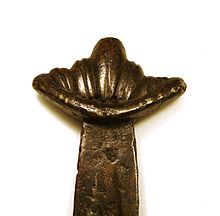Cawoodsværdet

Cawoodsværdet er et sværd fra vikingetiden eller den tidlige middelalder, der er fundet i floden Ouse ved Cawood i North Yorkshire i England i slutningen af 1800-tallet.[1] Det har en klinge af Oakeshott type XII,[2] og det anses som "et af de fineste vikingesværd som nogensinde er fundet"[3] og det bedst bevarede af de fem sværd af denne type, som er fundet.

Sværdet er 95 cm langt[4] og er dateret til omkring år 1100.[5] På begge sider af klingen er der inskriptioner, som muligvis er runer, men de er endnu ikke tydet.[3] Pommelen gjorde, at det er kaldt et vikingesværd, men der uenighed om denne kategorisering.[6]
Det var udstillet på Tower of London til 1956, hvor det blev solgt til en privat.[7] I 1987 blev det udstillet i The Age of Chivalry-udstillingen på Burlington House. I december 2007 blev sværdet købt af Yorkshire Museum i York.[8] Siden 2017 har det indgået som en af de vigtigste genstande i museets udstilling 'Medieval York: Capital of the North'.[9]
Referencer
- ^ Før 1861 eftersom det beskrives i A catalogue of the antiquities and works of art, Exhibited at the Ironmonger's Hall volume 1, maj 1861, sid. 151.
- ^ Ewart Oakeshott, The Sword in the Age of Chivalry (1964). S. 97
- ^ a b Yorkshire Museum and Gardens (18. december 2007). "The Cawood Sword". Hentet 31. december 2014.
One of the finest Viking swords ever discovered...
- ^ Totallængde 37½ tum egentligt Proceedings of the Society of Antiquaries of London, vol. 2, 1914, sid. 112.
- ^ Ewart Oakeshott, 1997, The Sword in the Age of Chivalry, ISBN 0-85115-362-3, sid. 145.
- ^ "The Korsoygaden sword, long believed to date to be of late Viking date, is in fact a Type XII. The hilt is almost exactly the same shape as that of the Cawood sword (also a XII), which by the style of the inlaid inscriptions in its blade may be placed with some confidence within a period between perhaps 1240 and 1310. Certainly no earlier than the former. The runes on the Korsoygaden hilt might have been made at any time between 1000 and 1300 (not later). Thus, in spite of being found in a stone coffin with the remains of a circular shield, it seems likely that the Korsoygaden sword must be of c. 1240-1300, not of c. 1000." Oakeshott (1964:98).
- ^ Ewart Oakeshott, 1996, The Archaeology of Weapons, ISBN 0-486-29288-6, sid. 219.
- ^ "Rescued relic". BBC News. 19. december 2007. Hentet 11. april 2016.
- ^ "MEDIEVAL YORK: CAPITAL OF THE NORTH". Yorkshire Museum. Hentet 4. oktober 2018.
Eksterne henvisninger
- The Cawood Sword på The Viking Rune.
Medier brugt på denne side
Forfatter/Opretter:
Forfatter/Opretter:

